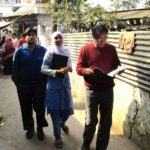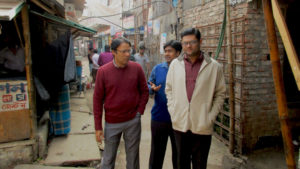
I followed community palliative care volunteer Samina through a maze of narrow, crowded alleyways to visit the invisible world of Korail, Bangladesh’s secret slum.
Home to an estimated 200,000 people, Korail remains largely uncharted territory. Mapping giants Google show no record of its existence, even though the slum’s population is greater than many UK cities. As the largest slum in Dhaka, Korail lies on 77 acres of reclaimed land beside a lake inside Bangladesh’s capital city.
The vastness of the slum quickly became apparent as I was navigating through it; every inch of Korail seemed to be occupied by people. People were continuously leaving and entering small shacks with bamboo frames and corrugated tin roofs that they called home. A group were sitting in front of a grocery shop watching a soap opera on a television fitted to the shop’s wall. Someone else was taking a bath in an open space just beside this shop. Barefoot children were playing in the street, and I could hear the call to prayer from the mosque at the end of the road.
This is a world in itself, extremely crowded and noisy, yet vibrant.
 In Korail it is difficult to realise where public space ends and a private space starts. Those who have watched Slumdog Millionaire will have a fair idea of what I mean.
In Korail it is difficult to realise where public space ends and a private space starts. Those who have watched Slumdog Millionaire will have a fair idea of what I mean.
Samina led me to a 10ft by 10ft tin shack where a family of five live. In the dark corner of this small room Amina, an elderly lady was lying alone. Samina told me that the couple who live here both work at the garment factory. They have three children who go to the school in Korail, run by an NGO.
Amina was the mother of the man. Suffering from cancer, she was at her end of her life. The man brought her from their village as there was no one to look after her. But at Korail, there was no one to look after her either. While they go to work and the children go to school, the family leave her lying on the floor, and whoever is available among their neighbours comes to feed her.
I sat beside Amina as she lay almost comatose on the floor. I couldn’t see her properly in the darkness. She just grabbed my hand and remained silent. It struck me there that even in the ‘invisible’ community of Korail, there are hidden people whom nobody notices.
There are 27 voluntary organizations working in different fields in Korail, including education, health, and income generation, but none that work for the people who are at the end of their life. Among this huge community, children are always born and people are always dying, but no one seems to be paying attention to dying.
It is only very recently that the palliative care unit of Bangabandhu Sheikh Mujib Medical University (BSMMU) in Dhaka started a community-based palliative care initiative. This is the project with which Samina works as a volunteer, and the project itself is a subject of my current study with the Global Interventions at the End of Life project.
The people of Korail are mostly migrants from rural Bangladesh, and are now significant elements of Dhaka’s workforce in the garment, transportation, construction, land development, domestic help, waste management, and informal sectors.
Despite their significant contribution to the economy, slum dwellers from Korail and elsewhere remain excluded from basic services, principally because slums are considered to be “illegal settlements.”
Once back on the bustling alleys of Korail, I was struck by a memory of my Lebanease colleague Dr Hala Kerbage describing her experience of navigating through the alleyways of a Syrian refugee camp in Lebanon, where she was working as a psychiatrist.
From Hala’s description, the refugee camp was just as crowded and cramped as Korail, but the atmosphere was quite different. In the refugee camp there were several frail, elderly people who had fled from air bombs and machine gun attacks in Syria, but were now facing critical medical conditions and had reached the end of their lives. But there was absolutely no concern for palliative care at that camp.
Hala told me the dramatic story of Mariam al-Khawli, whom she met at the refugee camp.
Mariam al-Khawli was a Syrian woman who had fled from her country with her husband and four children to Lebanon, but tried to set herself on fire soon after out of frustration over living without food and cash following a UN cutback.
Khawali told a reporter:
“We were very hungry, but they burned my heart long before I burned my body; they burned my heart from the inside”.
It is most likely that Khawali has died by now.
There is an Icelandic belief that there are a hidden people who reside in the rocks and hills, called the ‘Huldufólk’. Building projects in Iceland are sometimes altered to prevent damaging the rocks in which where they are believed to live.
This is the legend behind how the ‘hidden people’ came into being:
One day, God came to visit Adam and Eve at their home. He sat in their beautiful garden and asked to meet all the couple’s children. However, Eve had only finished bathing a few of her children, and was embarrassed to show her Creator the dirty ones. So, she introduced the clean children and hid the others.
“Are there any children I haven’t met yet?” God asked. Eve said “No”.
Of course, being omniscient, God knew that he was being deceived and declared, “Those who you hide from me shall also be hidden from men”.
And so, the hidden children became invisible, taking to the hills and moors and rocks. It is from these children that the ‘hidden people’ are descended, while humankind is descended from the children whom Eve showed to God.
Every day hundreds of people die in refugee camps, perhaps not as passionately as Khawali. Dying refugees very rarely receive any form of end of life care. Is palliative care a luxury in this complex humanitarian situation? Are these dying people in the refugee camp also a hidden people?
And in the slums of the world very few benefit from palliative care.
It would appear that slum dwellers and refugees are today’s Huldufólk, the hidden people. Why is that? Is it because they are the ‘dirty’ ones?
Shahaduz Zaman


Wishes more people care to refugees in the future, and no such case in the future.
very good blog, very useful for the information and the structure of the writing style, I will come back again for more information